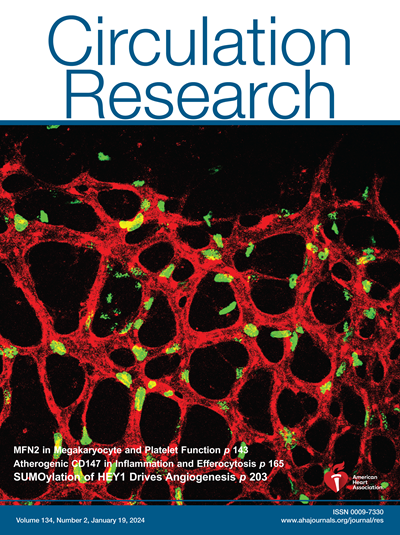miR-3154: Novel Pathogenic and Therapeutic Target in Abdominal Aortic Aneurysm.
IF 16.2
1区 医学
Q1 CARDIAC & CARDIOVASCULAR SYSTEMS
引用次数: 0
Abstract
BACKGROUND Abdominal aortic aneurysm (AAA) is a life-threatening condition with no effective pharmacological treatments currently available, likely due to our incomplete understanding of the molecular mechanisms underlying AAA pathogenesis and progression. In many cardiovascular diseases, circulatory microRNAs are potential diagnostic and prognostic biomarkers. Therefore, we investigated novel microRNAs with diagnostic and therapeutic potential in AAA. METHODS We performed microRNA expression analysis in aorta specimens isolated from mice with saline-induced or Ang II (angiotensin II)-induced AAA, wherein microRNA-3154 (miR-3154) was identified as a potential key molecule in AAA pathogenesis. We used RNA-sequencing analysis, cell migration assays, immunoblotting, protein interactome analysis, coimmunoprecipitation, molecular docking, and molecular dynamics simulation to determine the role of miR-3154 in AAA pathogenesis, clarify the phenotype, and elucidate the underlying molecular mechanisms. RESULTS Using high-throughput sequencing, miR-3154 was identified in the aortic tissue of ApoE-/- mice with AAA as compared with control mice. Increased miR-3154 expression was confirmed in the early-stage Ang II-induced AA mouse model and the aortic tissues of patients with AAA. Patients with AAA had higher serum miR-3154 level, which positively correlated with computed tomography-estimated size of the aneurysm. Functionally, miR-3154 dose-dependently aggravated vascular smooth muscle cell phenotypic switching and AAA development, both in vivo and in vitro. In vascular smooth muscle cells, TNS1 (tensin-1) was identified as a direct target of miR-3154. Mechanistically, TNS1 interacts with the R1-R13 domain of TLN1 (talin-1), thereby suppressing Sp1 (specificity protein 1) phosphorylation at Thr739 and upregulating MEOX1 (mesenchyme homeobox 1) expression-a key transcription factor regulating vascular smooth muscle cell phenotypic switching. CONCLUSIONS We uncovered a novel pathogenic role of miR-3154 in AAA, suggesting its potential as both a therapeutic target and prognostic biomarker.miR-3154:腹主动脉瘤的新致病和治疗靶点。
腹主动脉瘤(AAA)是一种危及生命的疾病,目前尚无有效的药物治疗方法,可能是由于我们对AAA发病和进展的分子机制了解不完全。在许多心血管疾病中,循环mirna是潜在的诊断和预后生物标志物。因此,我们研究了在AAA中具有诊断和治疗潜力的新型microRNA。方法我们对盐诱导或Ang II(血管紧张素II)诱导的AAA小鼠的主动脉标本进行了microRNA表达分析,其中microRNA-3154 (miR-3154)被确定为AAA发病机制的潜在关键分子。我们使用rna测序分析、细胞迁移测定、免疫印迹、蛋白相互作用组分析、共免疫沉淀、分子对接和分子动力学模拟来确定miR-3154在AAA发病机制中的作用,阐明其表型,并阐明其潜在的分子机制。结果通过高通量测序,与对照组小鼠相比,ApoE-/- AAA小鼠的主动脉组织中鉴定出miR-3154。在早期angii诱导的AA小鼠模型和AAA患者的主动脉组织中证实了miR-3154表达升高,AAA患者血清miR-3154水平较高,这与计算机断层扫描估计的动脉瘤大小呈正相关。在功能上,在体内和体外,miR-3154剂量依赖性地加重了血管平滑肌细胞表型转换和AAA发展。在血管平滑肌细胞中,TNS1(紧张素-1)被确定为miR-3154的直接靶点。在机制上,TNS1与TLN1 (talin-1)的R1-R13结构域相互作用,从而抑制Sp1(特异性蛋白1)在Thr739位点的磷酸化,并上调MEOX1(间质同源盒1)的表达,MEOX1是调节血管平滑肌细胞表型转换的关键转录因子。我们发现了miR-3154在AAA中的一种新的致病作用,表明其作为治疗靶点和预后生物标志物的潜力。
本文章由计算机程序翻译,如有差异,请以英文原文为准。
求助全文
约1分钟内获得全文
求助全文
来源期刊

Circulation research
医学-外周血管病
CiteScore
29.60
自引率
2.00%
发文量
535
审稿时长
3-6 weeks
期刊介绍:
Circulation Research is a peer-reviewed journal that serves as a forum for the highest quality research in basic cardiovascular biology. The journal publishes studies that utilize state-of-the-art approaches to investigate mechanisms of human disease, as well as translational and clinical research that provide fundamental insights into the basis of disease and the mechanism of therapies.
Circulation Research has a broad audience that includes clinical and academic cardiologists, basic cardiovascular scientists, physiologists, cellular and molecular biologists, and cardiovascular pharmacologists. The journal aims to advance the understanding of cardiovascular biology and disease by disseminating cutting-edge research to these diverse communities.
In terms of indexing, Circulation Research is included in several prominent scientific databases, including BIOSIS, CAB Abstracts, Chemical Abstracts, Current Contents, EMBASE, and MEDLINE. This ensures that the journal's articles are easily discoverable and accessible to researchers in the field.
Overall, Circulation Research is a reputable publication that attracts high-quality research and provides a platform for the dissemination of important findings in basic cardiovascular biology and its translational and clinical applications.
 求助内容:
求助内容: 应助结果提醒方式:
应助结果提醒方式:


